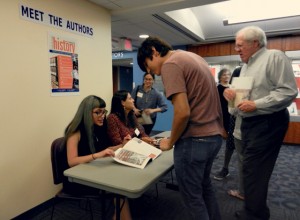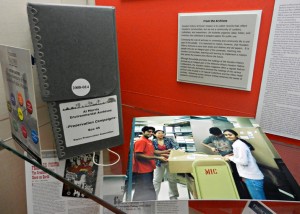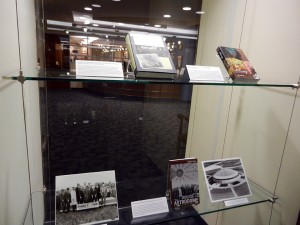
This Is Our Home, It Is Not for Sale (This Is Our Home) is the title of Jon Schwartz’s 1987 documentary film that chronicles Houston’s Riverside neighborhood. While it is the story of a specific neighborhood in Houston, the themes of segregation, integration, white flight and disparity of city services are common elements in the history of many large American cities. This Is Our Home, which boasts an impressive 3 hour and 20 minute run time, includes interviews with some of Houston’s most famous and influential residents. The University of Houston Library Special Collections is home to the This Is Our Home, It Is Not For Sale Film Collection, which includes Schwartz’s original production documents, photographs, and production films, including B-roll footage and early edits of the documentary.
The original production used a dual reel system of motion picture and a separate fullcoat magnetic soundtrack that requires syncing to achieve a digitized video product. These films were at particular risk of loss due to the use of fullcoat magnetic soundtrack in production, making it susceptible to extreme vinegar syndrome. The films, used in the editing process, also featured numerous splices and missing portions which were utilized in edits of the documentary. In 2017, The University of Houston Libraries was awarded a Texas Libraries and Archives Commission TexTreasures grant to digitize 112 filmed interviews, and make them available via our AudioVisual Repository. These raw interviews provide insights both into the former and current residents opinions of the neighborhood that had undergone a drastic transition, they are primary documents of individuals struggling to discuss the complexities of race relations and emotional attachments to “home.”
The Story of Riverside
In the 1920s, members of Houston’s wealthy Jewish community were blocked from home ownership in Houston’s elite River Oaks neighborhood by anti-Semitic deed restrictions. In response to these restrictions, the community helped to establish the affluent Riverside neighborhood, located to the west of University of Houston’s central campus. The neighborhood, inhabited by Jewish and non-Jewish residents, became the center of Jewish culture in Houston and was home to many influential Houston families. In 1952, Jack Caesar, a wealthy cattle rancher, moved to Riverside by instructing his white secretary to buy a home and transfer the deed over to Caesar, defying deed restrictions that blocked black individuals from purchasing homes in the area. His arrival on Wichita Street was first met with a buyout offer from neighbors who had pooled their money. Caesar refused the offer, and a dynamite bomb was detonated on the porch of the Caesar family’s home. Unharmed and undeterred, the family remained in Riverside. With landmark Supreme Court cases including District of Columbia v. John R. Thompson Co. Inc. (1953) and Brown v. Board of Education (1954) finding segregating policies unlawful, more affluent black families bought homes in the neighborhood.
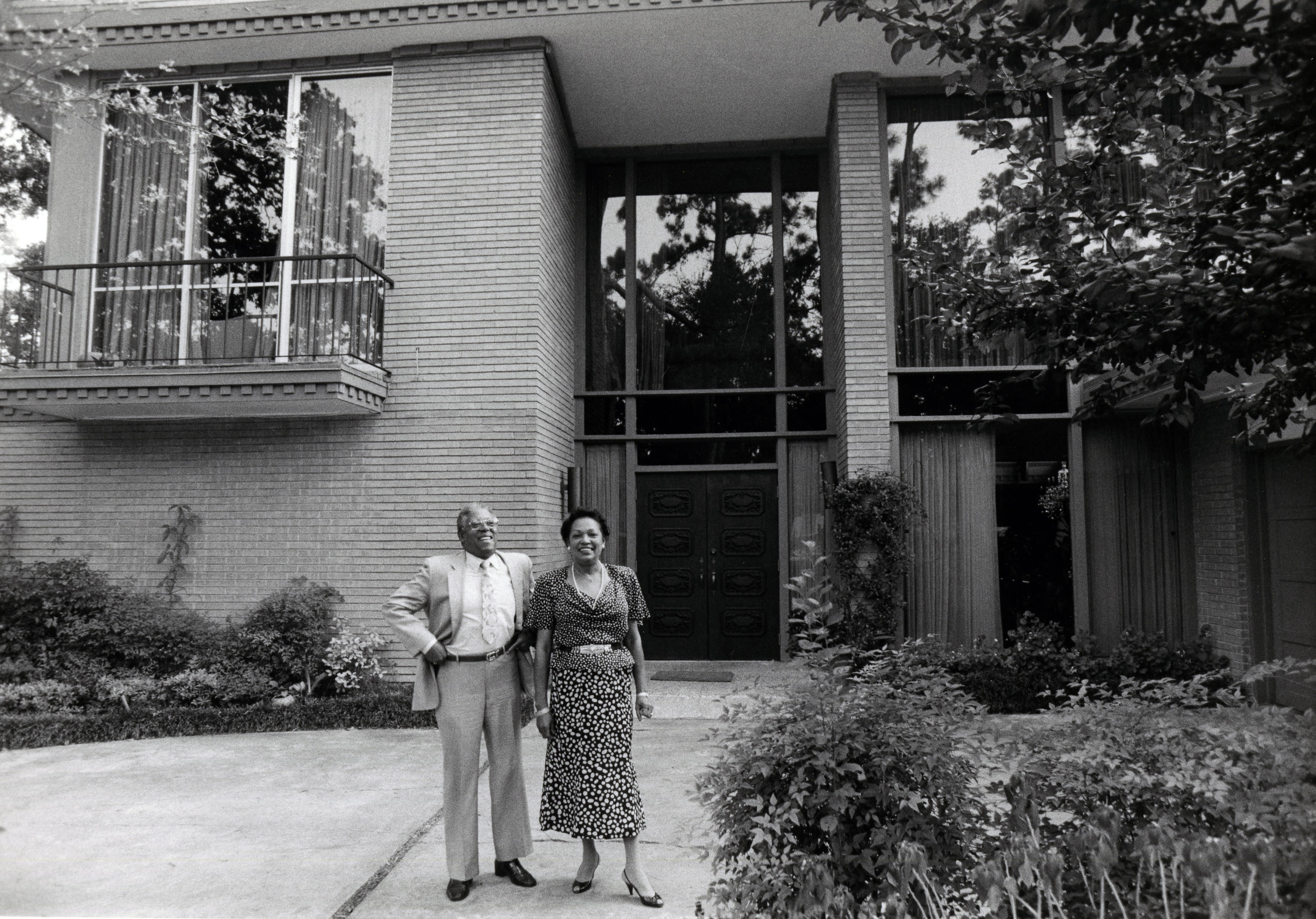
John and Drucie Chase standing in front of their Riverside home, designed by John Chase. From the This Is Our Home, It Is Not For Sale Film Collection.
In response to the influx of black residents and spurred on by unscrupulous real estate agents instigating anxieties about falling home values, many white residents sold their homes and moved to other areas of the city. Residents who hoped to maintain the neighborhood as an integrated community began a yard sign campaign that proclaimed “This Is Our Home, It Is Not for Sale.” While this movement gained national attention, it was not enough to slow the departure of white homeowners. Riverside continued to be shaped by forces including the departure of area businesses, the growth of UH and TSU campuses, construction of Highway 288, and the decision to locate a county psychiatric hospital in the neighborhood. In the late 1980s, white homebuyers attracted by Riverside’s beautiful homes, central location, and reasonable prices, began moving back into the area.
Through interviews with former and current residents of Riverside, This Is Our Home examines how anti-Semitism, racism, real estate agent-driven blockbusting, profiteering, white flight, and urban development projects created and continue to shape what was once one of the Houston’s most desirable neighborhoods.
Now Online
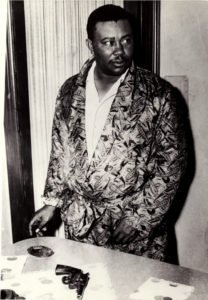
Jack Caesar, photographed with personal firearm following the bombing of his home (This Is Our Home, It Is Not For Sale Film Collection).
It is our hope that these materials will serve as a valuable resource, in complement to Schwartz’s documentary, and aid in scholarship around Houston. These primary source materials that trace the waves of segregation and desegregation dynamics in a large southern city and reveal the tensions related to population growth and demographic shifts. Not only do they document a segment of Houston history, but they also provide a profile of urban development with implications beyond the city and the region. Likewise, architectural historians, urban planners, historical geographers, and public administrators figure among the populations who may benefit from access to the complete, raw interviews.
All digitized raw interviews are available through the UHL Audiovisual Repository, and we have curated an online exhibition featuring an interactive map of the neighborhood highlighting interviews with Riverside’s residents. The full documentary can be viewed in the Special Collections Reading Room or purchased at http://thisisourhomeitisnotforsale.com/.
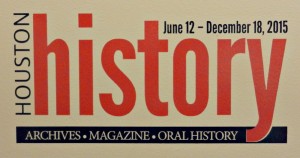 Now is your last chance to catch the exhibition, Houston History: Archives, Magazine, and Oral History on the first floor of the M.D. Anderson Library. Scheduled to close on December 18, 2015, staff will begin striking the exhibition any day now as we make way for a new installation, Encuentros en Literatura | Encounters and Discoveries in Literature, scheduled to open late January 2016.
Now is your last chance to catch the exhibition, Houston History: Archives, Magazine, and Oral History on the first floor of the M.D. Anderson Library. Scheduled to close on December 18, 2015, staff will begin striking the exhibition any day now as we make way for a new installation, Encuentros en Literatura | Encounters and Discoveries in Literature, scheduled to open late January 2016.
The exhibit, now ending a successful six month run, explores the impact of the Welcome Wilson Houston History Collaborative (formerly known as the Houston History Project) on research and scholarship related to Houston’s history. Dr. Tomkins-Walsh, curator of the exhibit and Archivist for the Houston History Archives, explains that in 2003 Dr. Joseph Pratt helped migrate the Houston History magazine from the Houston Public Library to the University of Houston and, in doing so, established an archive and repository of oral histories to complement the publication and help spur future research.
The Houston History magazine, published triannually, is the most prominent and publicly visible organ of the Welcome Wilson Houston History Collaborative. Students help support the day-to-day work of publishing the magazine but, even more importantly, students find a vehicle for publication of their research, often conducted in the archives and oral histories of the Houston History Archives. Dr. Tomkins-Walsh’s exhibition features prime examples of this type of student research and contributing authors even attended the exhibition’s opening, allowing them to highlight their research to a different audience and in a different context.
The Oral Histories from the Houston History Project are produced throughout the year by faculty and graduate students and prepared for online and global access by researchers via our Digital Library. The resource is constantly growing as new oral histories are produced and introduced into the existing collection. Included among the oral histories are interviews related to the energy history of Houston, the construction of the Houston Ship Channel, as well as the fallout from natural disasters like Hurricane Katrina. The Houston History exhibit is able to showcase the under-appreciated and under-publicized role of the oral history interviewer. Through the Center for Public History, graduate students are able to train in the skills, tools, and processes needed to research, prepare for, and conduct successful oral history interviews.
Finally, the paper archives that comprise the Houston History Project are also showcased. Representing a variety of research disciplines, highlights from the archival collections that make appearances in the exhibit include the Foley’s Department Store Records, the Thomas R. Cole Desegregation Papers, and records covering the production of the documentary film, This is Our Home, It Is Not for Sale. A number of other collections like the Bayou Preservation Association and the Citizens’ Environmental Coalition (CEC) provide a window into the peculiar push-pull relationship that developed over the years in Houston between disparate environmental groups and those interested in furthering business development.
However, all good things must come to an end, and time is running out for Houston History: Archives, Magazine, and Oral History. Be sure to catch one last glimpse of this exhibition, while you still can!
If you have not visited the M.D. Anderson Library recently, you should know that right now we have quite a bit we would like to show you.
Here at the University of Houston Special Collections we continue to shine light on the fruits of research’s labor. Our mini-exhibition, “From Our Collections…” is currently featuring a rotation of three new works that may be viewed at the entrance to Special Collections in the Aristotle J. Economon, Hanneke Faber & Andrew J. Economon Elevator Lobby exhibit space on the second floor. Now highlighting the breadth and variety of research potential contained in our collections are the following:
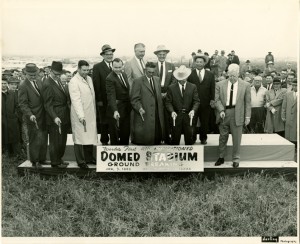
Breaking ground on the “World’s First Air Conditioned Domed Stadium” using Colt .45 pistols in lieu of the more traditional golden shovels (1962, from the George Kirksey Papers), featured on the cover of James Gast’s The Astrodome: Building an American Spectacle.
Incredible Tretchikoff: Life of an Artist and Adventurer, Boris Gorelik (2013); featuring research from the Cruiser Houston Collection.
The Other Great Migration: The Movement of Rural African Americans to Houston, 1900-1941, Bernadette Pruitt (2013); featuring research from the Oral Histories – Houston History Project.
The Astrodome: Building an American Spectacle, James Gast (2014); featuring research from the George Kirksey Papers.
In addition, Pat Bozeman’s exhibit, “1914-2014: Commemorating One Hundred Years — World War I,” continues it’s run at the foot of the Morrie & Rolaine Abramson Grand Staircase on the first floor of the M.D. Anderson Library. Timed in part to commemorate the 100 year anniversary of the armistice, the exhibit features maps, poetry, prose, and propaganda representing a number of the Great War’s belligerent nations.
Also on the first floor you can find the celebrated “Nina Vance and The Alley Theatre: A Life’s Work,” a collaborative curatorial effort carried out by our own Stacey Lavender along with Catherine Essinger, Librarian for UH’s Architecture & Art Library. The exhibit chronicles the people, plays, and places that have made the Alley Theatre what it is today.
Finally, if you have visited us before here on the second floor, you have no doubt experienced our USS Houston permanent exhibition. Pulling letters, photographs, artifacts, and more from our popular Cruiser Houston Collection, the exhibit illustrates the long peacetime and wartime history of a ship that earned the nickname the “Galloping Ghost of the Java Coast” and the sailors who served on her.
But wait, there’s more! Can’t make the trip to campus? I’d be remiss if I failed to mention our growing list of online exhibitions, open 24/7, 365 days a year. A couple of my favorites are UH Homecoming Through the Years, where curators Matt Richardson and Sara Craig draw from our rich University Archives to tell the story of our homecoming traditions, and From American Football to ZZ Top: A History of Robertson Stadium, that highlights the history of the 70 year old stadium that was demolished in 2012 to make way for the new TDECU Stadium.
More information regarding our exhibits, past and present, can be found online here. Hope to see you soon!
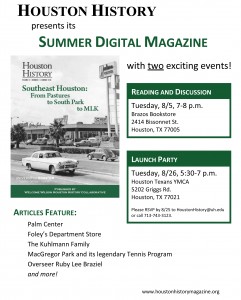
The summer 2014 digital issue of Houston History features a piece on the history of Foley’s in the city of Houston
The second digital issue of Houston History (Summer 2014) is on the virtual shelves and features a piece by our own Dr. Tomkins-Walsh, “From the Archives: Remembering Foley’s,” featuring research and images from the Foley’s Department Store Records.
We have written previously, lamenting the demise of a Foley’s presence, influencing and shaping Houston’s downtown, prior to the ultimate demolition of Kenneth Franzheim‘s bold design. For her part, Dr. Tomkins-Walsh addresses the demolition of that building in September of 2013 as something of a catalyst on the collective, public memory that wants not for a building, but instead represents more of a nostalgia and longing for an old figurative pillar and community partner long gone. From its origins as a dry goods store, to an early department store, through the post-war optimism reflected in the construction of Kenneth Franzheim’s icon, to the role it played in the desegregation of Houston, and on into the growth of branch stores that followed the patterns of suburban development, Tomkins-Walsh outlines in detail the symbiotic relationship that Foley’s enjoyed with the community, as well as the rich research potential the meticulous records hold across a number of fields of study.
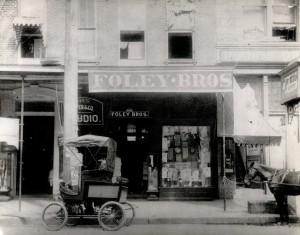
Foley Bros. on Main St. (1906) – available for high resolution download at our digital library
Subscribers of Houston History may read Dr. Tomkins-Walsh’s article and the rest of the latest digital issue online at the magazine’s website. In addition, a launch party for the summer digital issue is scheduled for Tuesday, August 26th from 5:30pm to 7:00pm at the Houston Texas YMCA (5202 Griggs Rd., Houston, TX 77021). Interested in learning more about the history of Houston as seen through that huge display window on Main Street? Plan a visit to the Special Collections Reading Room and take a closer look at the Foley’s Department Store Records.
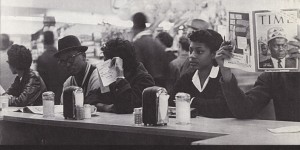 The Museum of Fine Arts, Houston will screen the film The Strange Demise of Jim Crow on Sunday, February 9th at 5pm in the Caroline Wiess Law Building.
The Museum of Fine Arts, Houston will screen the film The Strange Demise of Jim Crow on Sunday, February 9th at 5pm in the Caroline Wiess Law Building.
Directed by David Berman, this 1998 film delves into the quiet inner-workings and subtle, sometimes shady, machinations of the process of desegregation of southern cities like Houston, where quiet compromise and media blackouts replaced the bombastic violence of fire hoses, police dogs, and street battles that engulfed other southern locales and burned themselves into the nation’s television screens. Tickets may be reserved in advance for free at the MFAH website. A panel discussion will follow the screening of the film, moderated by co-producer Thomas R. Cole.
At the University of Houston Special Collections, we are proud to make available for study the Thomas R. Cole Desegregation Papers. Part of the Houston History Archives, the Thomas R. Cole Desegregation Papers contain the research materials that went into the making of this film. As we have written previously, these papers are an excellent starting point for anyone interested in researching the unique path to desegregation that cities like Houston followed. The collection contains drafts of scripts for the film, correspondence related to fundraising, and a variety of materials related to the topic of segregation as well as publicity for the film. We invite you to review the detailed finding aid and visit us at your leisure to study these rich materials.

